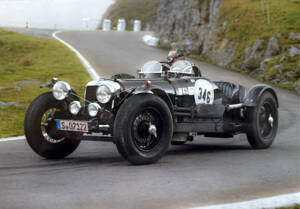- Automobile
- Alvis
- Alvis 12 / 70 (1 offerta)
Alvis 12 / 70 Classic Cars for Sale
The Alvis 12/70, built from 1937 to 1940, stands out with its four-cylinder engine, sharp design by George Lanchester, and a chassis adaptable for saloon, cabriolet, or roadster bodies. This model, renowned for Mulliners of Birmingham bodywork and brown leather interiors, remains one of Alvis's rarer survivors, with only 121 units known today. Discover more about its detailed technical features and coachbuilt elegance below.
Risultati della ricerca

1939 | Alvis 12 / 70
Vielleicht einer der schönsten Alvis Specials?
History of the Alvis 12/70
Introduced on 22 September 1937, the Alvis 12/70 filled the segment between the outgoing Firebird and the larger Silver Crest. Conceived during a period of transition, George Lanchester handled the design while the primary Alvis design lead was occupied with factory expansion. This marked Lanchester's final automotive creation. Despite production challenges due to impending war, Alvis managed to build 741 examples of the 12/70, offering buyers a well-appointed, mid-sized four-seater with advanced features for its era. The 12/70's production concluded in 1940 owing to wartime restrictions. Postwar, the TA 14 succeeded the 12/70, inheriting several chassis and design cues from its predecessor.
Model History: Alvis 12/70 Series
The 12/70 replaced the Firebird (1934–1936) and served as a lighter, more affordable counterpart to the Silver Crest. Introduced just before World War II, its production run was short but significant. The main bodywork came from Mulliners of Birmingham, and the model was sold as two- or four-door saloon, cabriolet, or roadster. In 1938, Alvis updated the model with the Type II, offering more spacious interiors and exterior boot mounting. Priced at £315 for the coupé and £435 for other variants, the 12/70 established Alvis as a flexible builder of refined, accessible sports-oriented touring cars.
Highlights and Unique Features
The Alvis 12/70 stands out for its coachbuilt adaptability, including a removable, tapered tail and a cockpit design said to evoke the Alfa Romeo 8C Monza. Luxurious brown leather, armrests and boot in matching trim, stone guard-meshed headlamps, hand-painted racing numbers, and dedicated fixings for a spare wheel and oil canister represented a level of customisation rarely matched in its class. Typical accessories such as external leather straps further underlined its semi-competition character.
Technical Data
Special Editions and Collectible Models
In 1938, the Type II 12/70 variant was introduced, standing out with a more spacious cabin, increased head- and legroom, and the practical relocation of the spare wheel to an external position. This improved version is especially sought after by collectors for its usability and slightly more refined interior appointments.
Weak Spots and Common Issues
No specific weak spots are mentioned in the available documentation. Potential buyers should pay special attention to the overall condition of the chassis, especially if the car retains original Mulliners coachwork. Given the 12/70's pre-war construction, checking for rust in the frame, wear in the leaf-spring suspension, and thorough inspection of the four-cylinder engine, especially for oil leaks and carburettor health, is recommended. The restoration status of leather interiors and the operational status of unique accessories (like stone guard-covered lamps and cockpit features) also merit careful review.
Engine, Performance and Handling
The 12/70's 1,842 cc engine delivers 46 kW, offering brisk performance for a car of its size and period, aided by the relatively light chassis and sporting setup. The four-speed manual transmission is robust, and the leaf-spring suspension, while traditional, provides a compliant and predictable ride. The presence of well-balanced coachwork options meant handling characteristics could vary, but all shared a competent road manner that suited long journeys as well as relaxed sporting use. Notable examples include the two- and four-door saloon, cabriolet, and roadster bodies, all with the same mechanical basis and notable for practical features like the external spare wheel mount and optional race-inspired cockpit details.
Design: Exterior and Interior
The 12/70 benefitted from the hand of George Lanchester, presenting a purposeful shape with a discreet yet sporting profile. Details such as brown leather upholstery, matching trim for both passenger compartment and boot, distinctive removable tapered tail, and period-correct instrumentation define the passenger experience. Noteworthy are the mesh-protected headlights and fog lights, leather bonnet straps, and custom-mounting for accessories. These details, together with the Alfa Romeo-inspired dashboard and the careful work of Mulliners, set the 12/70 apart from its contemporaries in exterior flair and interior comfort.
Other Noteworthy Features
The Alvis 12/70 was renowned for its adaptability—not just in body style but also in specification, as various external fixings (like oil can holders, external race number mounts, and unique luggage solutions) catered to both everyday use and period competition. These features, combined with its competitive pricing and robustness, ensured the 12/70 could be configured for a range of uses, from refined tourer to occasional rally participant.
Summary
The Alvis 12/70 exemplifies late-1930s British automotive engineering, blending a robust four-cylinder engine with distinctive coachbuilt design and a rich offering of custom details. Limited production and high survival rates today make the 12/70 a stand-out option for collectors seeking a practical, stylish, and historically significant classic. All listings and buyer interest on our platform currently focus exclusively on this model, confirming its leading status in the classic Alvis range.
